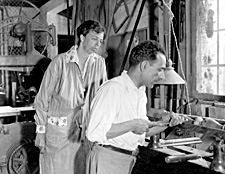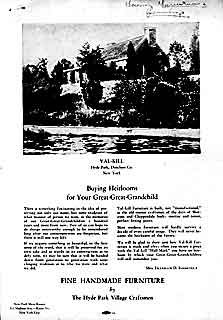|
|
|
|
|
|
 |
|
|
|
|
|
|
|
|
|
|
|
|
|
|
|
|
|
 |
|
|
Eleanor and her friends Nancy Cook, Marion Dickerman, and Caroline O'Day founded Val-Kill Industries in 1926. Conceived as a social experiment, Val-Kill Industries was designed to provide local farmers and their families with the necessary crafting skills to supplement their income. Eleanor's appreciation for the handicraft tradition fueled her interest in the American Colonial Revival Movement.
|
|
|
|
 |
|
Eleanor Roosevelt in the Val-Kill Industries work area
Eleanor Roosevelt National Historic Site, ELRO 469
|
|
|
 |
|
|
Val-Kill tapped a lucrative reproduction furniture market generated by increasing interest in the nation's colonial heritage. Val-Kill craftsmen produced high quality replicas and adaptations of early American furniture and pewter.
|
|
 |
|
Eleanor Roosevelt and Frank Landolpha at the lathe in the Val-Kill Industries work area
Eleanor Roosevelt National Historic Site, ELRO 469
|
|
|
|
Of the four partners, Nancy and Eleanor were the most actively involved. Eleanor handled marketing. Nancy, a trained and skilled woodworker, designed furniture and managed the shop.
|
|
|
 |
|
 |
|
Val-Kill Advertisement
Paper. L 28.0, W 19.5 cm
Eleanor Roosevelt National Historic Site, ELRO 2822
Click to enlarge.
|
|
|
|
|
|
|
 |
|
 |
|
|
|
|
Frank Landolfa and Otto Berge were the principal craftsmen. Otto's brother Arnold came to Val-Kill as an apprentice in the furniture shop. In 1934, the Val-Kill partners established the Val-Kill Forge and hired Arnold as metal smith. The forge produced a wide range of common pewter pieces based on both colonial and contemporary forms.
|
|
|
Val-Kill Industries continued in operation until 1937 when Eleanor and her friends dissolved their partnership. The equipment from the furniture shop was given to Otto Berge, and the forge was given to Arnold Berge.
|
|
|
 |
|
|
|
|
|
 |
|
 |
|
|
 |
|
 |
|
|
|
Click buttons above for more images.
|
|
|
|
|
|
|
|
|
|
|
|
|
|
|
|
|
|
|
|
|
|